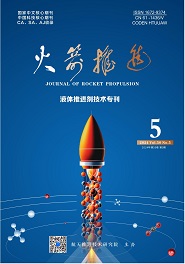航天推进技术研究院主办
ZHANG Qian,WANG Bing,ZHANG Yun-long,et al.A theoretical prediction method of ignition distance in supersonic mixing layer[J].Journal of Rocket Propulsion,2015,41(01):50-55.
超音速混合层着火距离的一种理论预测方法
- Title:
- A theoretical prediction method of ignition distance in supersonic mixing layer
- Keywords:
- supersonic plane mixing layer; ignition distance; theoretical prediction; numerical simulation
- 分类号:
- V0357.5-34
- 文献标志码:
- A
- 摘要:
- 提出了超音速混合层着火距离的一种理论预测方法。基于超音速混合层来流热力学参数和考虑粘性加热及可压缩性效应的修正温度,定义了密闭容器反应系统。耦合详细化学反应机理获得该系统的着火延迟时间,并基于超音速混合层的平均流动速度获得了着火距离。其预测结果与高精度数值模拟结果相符,同时该理论预测方法能够从物理上很清晰地解释已有研究中所观察到的着火距离随相关影响因素的变化规律。同时,该预测方法为定性认识超音速着火距离及其变化规律提供了简易可行的途径,为耦合有限试验和数值模拟结果实现着火距离的定量预测提供了理论支撑。
- Abstract:
- A theoretical method is proposed for the prediction of the ignition distances in the supersonic mixing layer. Based on the inlet thermodynamics parameters and the correction temperature related to viscous heating and compressibility effect, a closed container reaction system is defined. The ignition delay time of the closed container reaction system are obtained through coupling the detailed chemical reaction mechanism. The ignition distance is got according to the mean flow velocity of the supersonic mixing layer. The ignition distances obtained by the theoretical prediction method agree well with those by CFD. The variation of the ignition distances with the related influence factors, which is observed in the previous studies, can be clearly explained in physics by the present theoretical prediction method. Besides, the theoretical prediction method for the ignition of ignition distance through coupling the limited experimental results with numerical simulation ones.
参考文献/References:
[1]孙明波, 梁剑寒, 金亮, 等. 二维超声速混合层的大涡模拟[J]. 国防科技大学学报, 2005, 27(6): 86-90.
[2]IM H G, CHAO B H, BECHTOLD J K, et al. Analysis of thermal ignition in the supersonic mixing layer[J]. AIAA Journal, 1994, 32(2): 341-349.
[3]JU Y, NIIOKA T. Reduced kinetic mechanism of ignition for nonpremixed hydrogen/air in a supersonic mixing layer [J]. Combust Flame, 1994, 99(2): 240-246.
[4]NISHIOKA M, LAW C K. A numerical study of ignition in the supersonic hydrogen/air laminar mixing layer[J]. Combust Flame, 1997, 108(1/2): 199-219.
[5]TAHSINI A M. Turbulence and additive effects on ignition delay in supersonic combustion[J]. P I Mech Eng G-J AER, 2013, 227(1): 93-99.
[6]REN Y X, LIU M, ZHANG H. A characteristic-wise hybrid compact-WENO scheme for solving hyperbolic conservation laws[J]. Journal of Comput Phys, 2003, 192(2): 365-386.
[7]EBERHARDT S, IMLAY S. Diagonal implicit scheme for computing flows with finite rate chemistry[J]. Journal of Thermophys Heat Tr, 1992, 6(2): 208-216.
[8]WANG C S, OSHER S. Efficient implementation of essentially non-oscillatory shock-capturing schemes[J]. Journal of Comput Phys, 1988, 77(2): 439-471.
[9]薛淑艳, 张会强, 王希麟. 超音速平板混合层被动标量的数值模拟[J]. 工程热物理学报, 2009, 30(8): 1423-1426.
[10]ZHANG Y L, WANG B, ZHANG H Q. The shock wave refraction in supersonic planar mixing layers[J]. Chinese Phys Letters, 2013, 30(8): 22-28.
[11]DRUMMOND J, MUKUNDA H. A numerical study of mixing enhancement in supersonic reacting flow fields, AIAA1988-3260[R]. USA: AIAA, 1988.
[12]DALE H, LYLE L, PHILIP M. Computation of a confined compressible mixing layer, AIAA 1995-2173[R]. USA: AIAA, 1995.
备注/Memo
收稿日期:2014-05-21;修回日期:2014-12-12 作者简介:张倩(1989—),女,助理研究员,研究生,研究领域为动力系统及膜冷却特性
